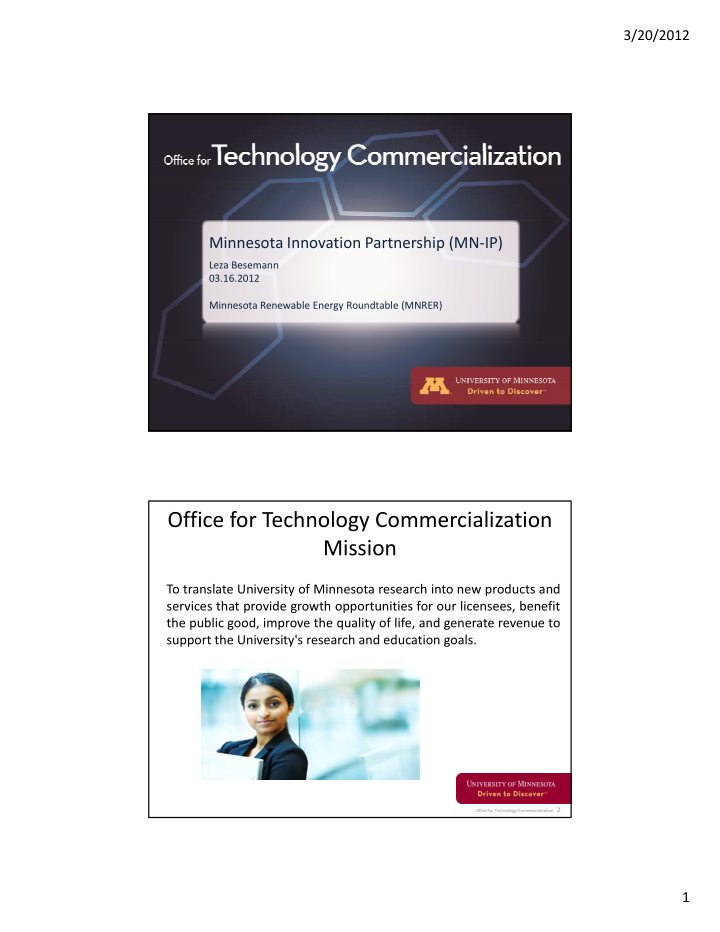



3/20/2012 Minnesota Innovation Partnership (MN ‐ IP) Leza Besemann 03.16.2012 Minnesota Renewable Energy Roundtable (MNRER) Office for Technology Commercialization Mission To translate University of Minnesota research into new products and services that provide growth opportunities for our licensees benefit services that provide growth opportunities for our licensees, benefit the public good, improve the quality of life, and generate revenue to support the University's research and education goals. Office for Technology Commercialization 2 1
3/20/2012 U:Industry Partnerships • Three traditional motivators for U:Industry relationships Translation of research to products p 1. Sponsored research funding 2. Royalty streams (technology transfer) 3. IP Innovation Innovation Public Business & Research Good Industry Universities Sponsored Research $ Office for Technology Commercialization 3 Funding as Motivation By the Numbers (FY 2011) Total Federal R&D funding = ~ $111 billion ~7.8% of Federal R&D to Universities = ~ $36.1 billion Total Industry R&D funding = ~ $265 billion ~1% Industry R&D to Universities = ~ $ 2.8 billion ~1% I d t R&D t U i iti ~ $ 2 8 billi Office for Technology Commercialization 4 2
3/20/2012 UMN Funding by Sponsor Office for Technology Commercialization 5 Royalties as Motivation • Misplaced Emphasis? “Patenting and licensing practices should not be predicated on the goal of raising significant revenue for institutions. The likelihood of success is small, the probability of disappointed expectations high and the risk of distorting and narrowing dissemination efforts great.” “Managing University Intellectual Property in the Public Interest”, National Research Council of the National Academies, 2010 In 2010, only 33 universities or university systems reported licensing income greater than $10 million. Association of University Technology Managers Office for Technology Commercialization 6 3
3/20/2012 Changing Motivations 1. Need to translate discoveries to marketable products Source of sponsored research (grant money) 2. Revenue stream ‐ Royalties from licensing and R R l i f li i d 3. commercialization of IP Federal and state pressures to contribute to competitiveness 4. Advantages of Strategic Partnerships 5. a. Improved approaches to complex research b. Intellectual cross ‐ fertilization c. Practical experiences for students d. Shared resources and experiences e. National competitiveness Office for Technology Commercialization 7 Facilitating Collaboration From Letter to Commerce Secretary Locke, endorsed by 135 University Presidents, April 2011 • “To facilitate university ‐ industry collaboration, we will: a. Further support programs that facilitate sharing of labs, facilities, student ‐ faculty teams, and other resources. b. Strengthen strategic investments in university ‐ industry collaborations aimed at advancing technologies of mutual interest and renowned research programs, designed to enhance market ‐ pull of research. c. Develop ways to incentivize and support industry R&D professionals p y pp y p to collaborate with universities. d. Encourage the development of accelerators and public ‐ private partnerships on or within close proximity to campuses; and find ways to provide innovation services to new enterprises external to the university.” Office for Technology Commercialization 8 4
3/20/2012 What Companies Value Hierarchy of Need Undergraduate Students Graduate Students Continuing Education Consortia and Centers Intellectual capital Professors for Consulting Sponsored Research Intellectual Property (IP) as com m only defined Licensing Licensing IP IP Office for Technology Commercialization 9 Enhancing Industry Relationships • New approaches to IP (intellectual property) a. Increasing use of master agreements g g b. Express licensing strategies c. Minnesota Innovation Partnerships (MN ‐ IP) • Office for Business Relations ‐ “front doors” • Research consortia • Collaborative partnerships supporting regional economic growth efforts Office for Technology Commercialization 10 5
3/20/2012 IP Office for Technology Commercialization 11 Minnesota Innovation Partnerships (MN ‐ IP) The following two options for establishing intellectual property rights are available to for profit entities that sponsor research at the University of Minnesota. • Option A was created to remove uncertainty and financial concerns that often surround industry funded research projects in a university setting. • Option B was created for those sponsors who do not wish to pay an upfront fee and are comfortable with the uncertainty. Office for Technology Commercialization 12 6
3/20/2012 MN ‐ IP Option A • Pre ‐ paid exclusive option fee a. 10% of sponsored research contract or $15K, whichever is greater • Company pays patent costs and has the benefit of driving prosecution while collaborating with the University on patent claims • Option to exclusive license with pre ‐ set terms a. No annual minimums or ‘other’ fees b. No time limits or milestones c. Sponsor is free to sublicense/cross license p / d. Each year licensee sales using licensed IP is ≥ $20M, licensee pays 1% royalties on net sales e. No cap on royalties unless invention improves on the sponsor’s pre ‐ existing product or processes Office for Technology Commercialization 13 Advantages of Option A • No negotiation needed • All terms and costs known before research starts • Stronger incentive (pre paid fees) for company to commercialize technology • Easier to work with the University on IP commercialization Office for Technology Commercialization 14 7
3/20/2012 MN ‐ IP Option B • Sponsor and university negotiate a royalty ‐ bearing license once the IP to be commercialized is developed • No upfront fees • No pre ‐ set royalties Office for Technology Commercialization 15 MN ‐ IP Impact MN ‐ IP program will give a company sponsoring research at the U the opportunity to pre ‐ pay an option fee and agree upfront to terms for an exclusive royalty ‐ free world ‐ wide license. l i lt f ld id li An industry leading strategy • A game ‐ changer • Makes UMN a research destination of choice • Office for Technology Commercialization 16 8
3/20/2012 MN ‐ IP Minnesota Innovation Partnerships For more information on MN ‐ IP http://www research umn edu/techcomm/industry sponsor html http://www.research.umn.edu/techcomm/industry ‐ sponsor.html Leza Besemann Technology Strategy Manager Office for Technology Commercialization 612.625.8615 besem007@umn.edu http://www.research.umn.edu/techcomm Office for Technology Commercialization 17 9
Recommend
More recommend